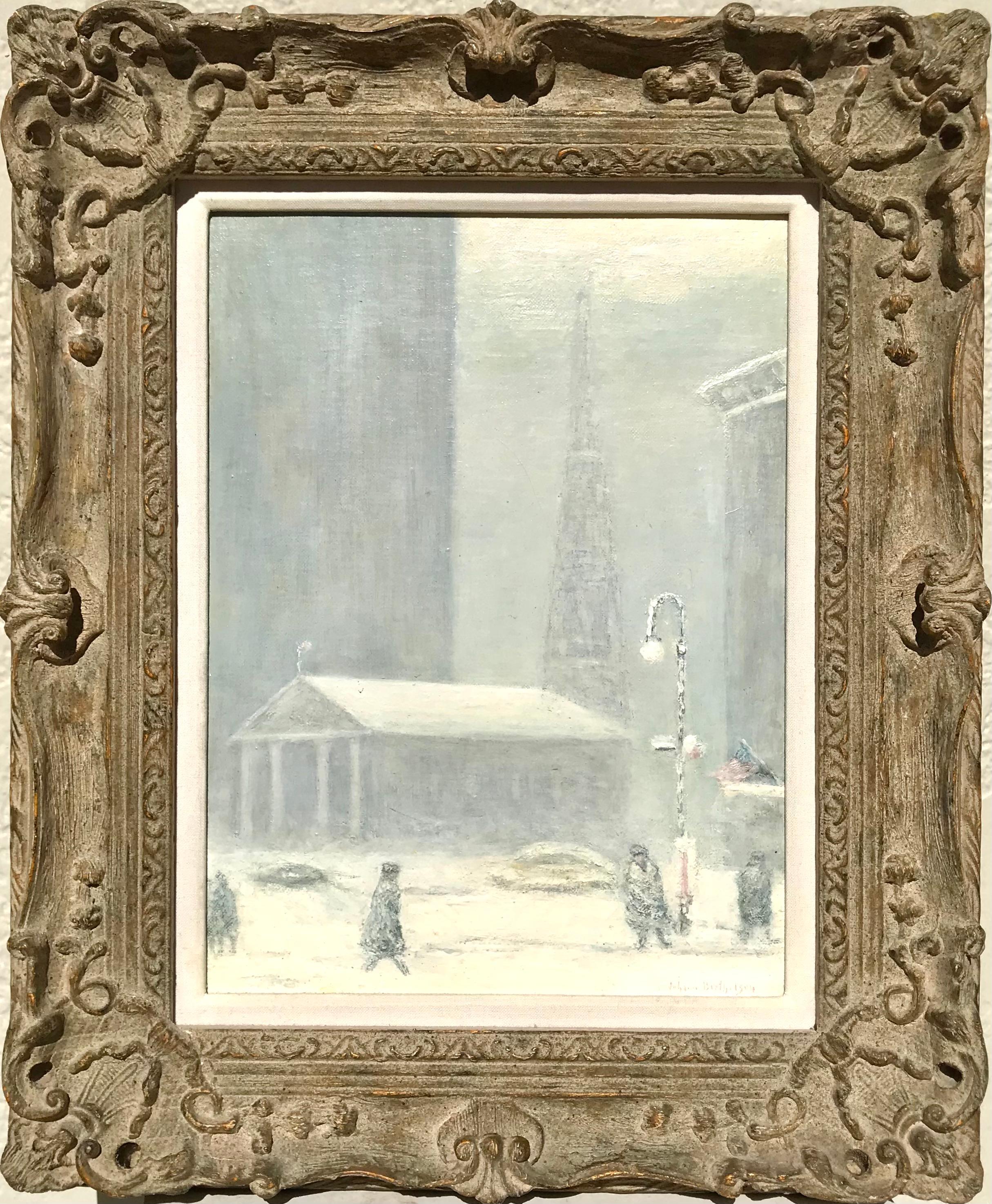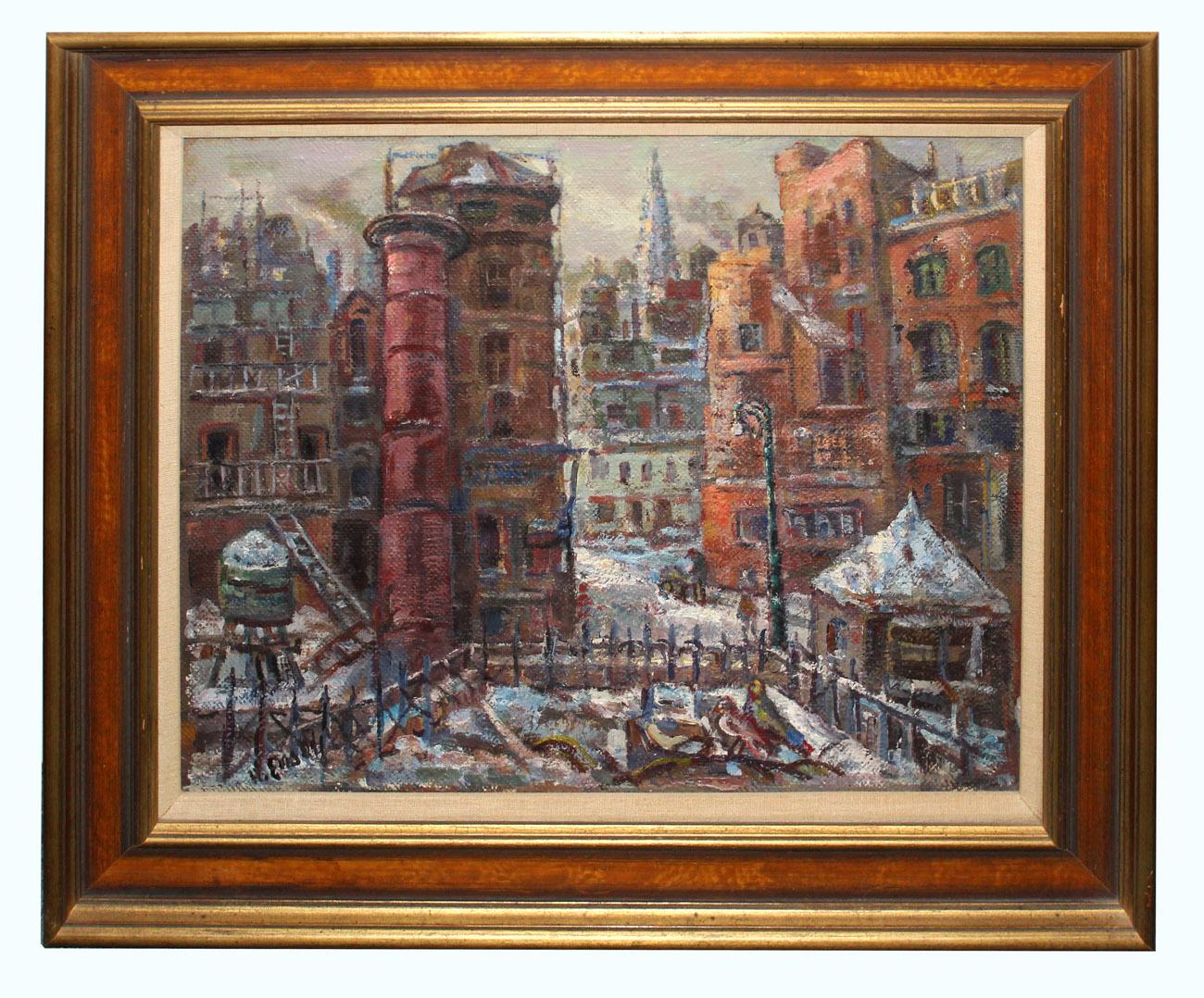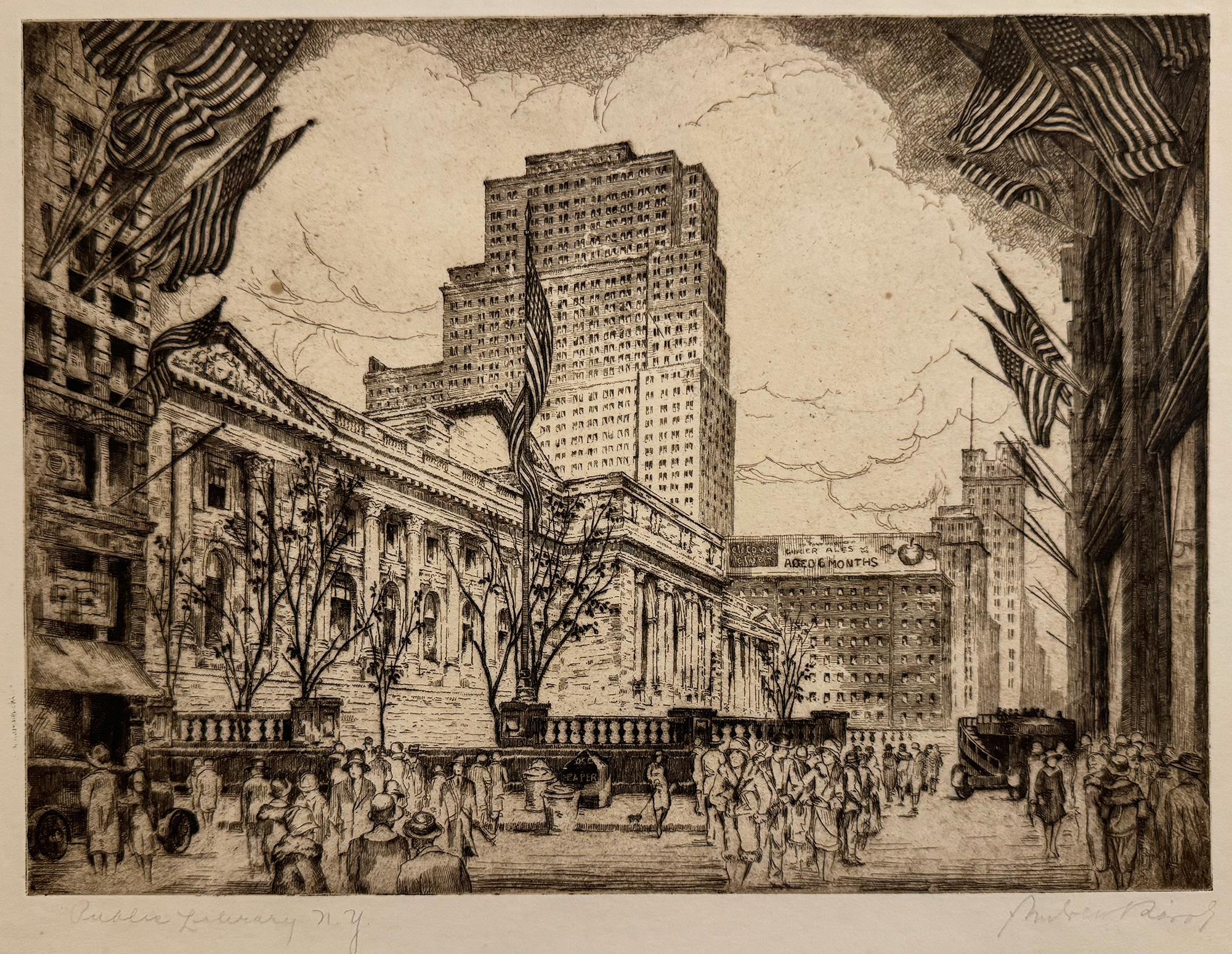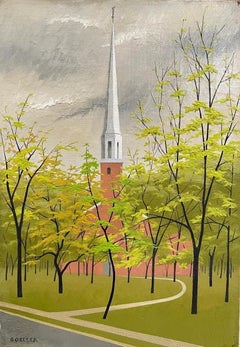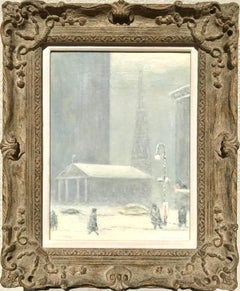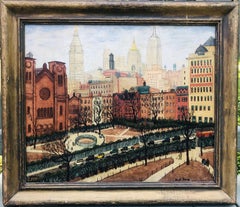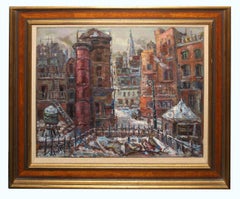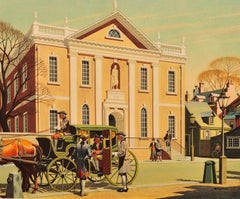Items Similar to Jefferson Market Library (Courthouse)
Want more images or videos?
Request additional images or videos from the seller
1 of 6
Charles W. AdamsJefferson Market Library (Courthouse)
$6,000
£4,454.68
€5,190.93
CA$8,329.94
A$9,317.56
CHF 4,848.91
MX$114,702.33
NOK 61,688.22
SEK 57,875.71
DKK 38,729.51
Shipping
Retrieving quote...The 1stDibs Promise:
Authenticity Guarantee,
Money-Back Guarantee,
24-Hour Cancellation
About the Item
This painting is part of our exhibition America Coast to Coast: Artists of the 1930s
Jefferson Market Library (Courthouse), c. 1930s, oil on canvas, 30 x 24 inches, signed lower right; presented in a newer silver painted frame
About the Painting
Writing about an exhibition of Charles W. Adams’ work at the Eighth Street Art Gallery in the mid-1930s, Emily Grenauer observed in The World-Telegram that the artist’s paintings were “distinguished for their solid form, well organized design and sumptuous color” and the art critic for The Herald Tribune found Adam’s work “a strong, formal realization of his subject . . . he paints with vital emphasis on structure and composition.” Although we do not know which works these critics referenced, it is likely they were writing about paintings like Jefferson Market Library (Courthouse). With its carefully designed reality, strong angles, solid forms, and well-disciplined puffs of smoke in the background, Adams presents a highly structured version of the Greenwich Village landmark, the Jefferson Market Library, which was a courthouse at the time Adams completed this work. The Jefferson Market Library was a prized subject for downtown painters, including the Ashcan School painter, John Sloan, the modernist, Stuart Davis, and the precisionist, Francis Criss.
About the Artist
Charles W. Adams was an American painter who was born in Oklahoma but achieved success in the New York area. Adams received his first artistic training at Muskogee’s Central School from Dr. Adah Robinson who would subsequently head the art department at the University of Tulsa. Adams later studied at the Art Institute of Chicago before settling in New York where he pursued an acting career. After touring as Gerald March in The Green Hat, Adams returned to New York to continue his art studies at the Art Students League with Frank DuMond. During the mid-1930s, Adams maintained a studio on Washington Square before moving to New Jersey in 1937. He exhibited at the Salons of America (New York), Rockefeller Center (New York), Junior League Art Gallery (Oklahoma), and the Ridgewood Art Association (New Jersey). He was represented by New York’s Eighth Street Art Gallery and ACA Gallery, Concerning paintings shown at ACA Gallery, The New York Times art critic wrote, “The two canvases by Mr. Adams reveal considerable originality and real feeling for the medium.” Other praise for Adams work came from The New York Sun art critic who wrote Adams is” nothing if not modern in his outlook,” and The World-Telegram art critic noted his compositions were “authoritatively and sharply designed. . . noteworthy in their texture as well.” Adams participated in the New Deal’s Federal Art Project and exhibited his artwork at the Federal Extension Gallery in 1939. The 1940 census lists Adams as a portrait painter, while the 1950 census indicates he was a professional artist working for a publishing company. Adams is listed in Who Was Who in American Art and other standard references.
- Creator:Charles W. Adams (1903, American)
- Dimensions:Height: 30 in (76.2 cm)Width: 24 in (60.96 cm)Depth: 2 in (5.08 cm)
- More Editions & Sizes:30 x 24Price: $6,000
- Medium:
- Movement & Style:
- Period:
- Condition:
- Gallery Location:Los Angeles, CA
- Reference Number:1stDibs: LU1859213056582
About the Seller
5.0
Vetted Professional Seller
Every seller passes strict standards for authenticity and reliability
1stDibs seller since 2022
15 sales on 1stDibs
Typical response time: 19 hours
- ShippingRetrieving quote...Shipping from: Los Angeles, CA
- Return Policy
Authenticity Guarantee
In the unlikely event there’s an issue with an item’s authenticity, contact us within 1 year for a full refund. DetailsMoney-Back Guarantee
If your item is not as described, is damaged in transit, or does not arrive, contact us within 7 days for a full refund. Details24-Hour Cancellation
You have a 24-hour grace period in which to reconsider your purchase, with no questions asked.Vetted Professional Sellers
Our world-class sellers must adhere to strict standards for service and quality, maintaining the integrity of our listings.Price-Match Guarantee
If you find that a seller listed the same item for a lower price elsewhere, we’ll match it.Trusted Global Delivery
Our best-in-class carrier network provides specialized shipping options worldwide, including custom delivery.More From This Seller
View AllThe Railway Station
Located in Los Angeles, CA
The Railway Station, c. 1934, oil on canvas, signed lower right, titled verso and noted "34"; illustrated Kaufman, Jeffrey, Brush with Life: The Art of Being Edward Biberman...
Category
1930s American Modern Landscape Paintings
Materials
Oil
Price Upon Request
Church in Trees
Located in Los Angeles, CA
This painting is part of our exhibition Charles Goeller: A Wistful Loneliness.
Oil on canvas, 13 x 9 inches, Signed lower left
Category
1940s American Modern Landscape Paintings
Materials
Oil, Canvas
Broadway
By Jean Dominique van Caulaert
Located in Los Angeles, CA
Broadway (?), 1952, oil on Masonite, signed and dated lower left, 15 x 18 inches, inscription verso may say "Broadway", presented in its original frame
Jean Dominique van Caulaert w...
Category
1950s Impressionist Landscape Paintings
Materials
Canvas, Oil
Gracie Mansion
By Isabella Banks Markell
Located in Los Angeles, CA
Gracie Mansion, c. 1944, oil on canvas, signed lower right, 25 x 30 inches, presented in a newer frame
Isabella Markell was a painter, etcher, and sculptor, who is best known for ...
Category
1940s American Modern Landscape Paintings
Materials
Canvas, Oil
Suburb (in Winter)
Located in Los Angeles, CA
This painting is part of our exhibition Charles Goeller: A Wistful Loneliness.
Oil on canvas, 20 x 15 inches, Signed lower right
Exhibited:
1) Portrai...
Category
1940s American Modern Landscape Paintings
Materials
Oil
Johnny Walker’s Place
By Georgina Klitgaard
Located in Los Angeles, CA
Johnny Walker’s Place, by 1929, oil on canvas, signed lower right, 34 x 42 inches, exhibited 1) 28th International Exhibition of Paintings, Carnegie Institute, Pittsburgh, PA, Octobe...
Category
1920s American Modern Landscape Paintings
Materials
Canvas, Oil
You May Also Like
St Pauls Chapel NYC
By Johann Berthelsen, 1883-1972
Located in Dallas, TX
Johann Berthelsen (Denmark, 1883- 1957)
'St. Paul's Chapel, NYC'.
Oil on canvas board.
Signed lower right. NY.
Property from a New Jersey estate.
Dimensions: 16" h x 12 " w.
Fra...
Category
1940s Aesthetic Movement Landscape Paintings
Materials
Oil
$3,760 Sale Price
20% Off
Important Modern Stuyvesant Square New York by Polish American Artist Mark Baum
Located in Exton, PA
Modernist Pre-War Oil Painting by well-listed artist Mark Baum. Baum was born in Poland in 1903 and came to NYC in 1919. He painted in water colors initially...
Category
1930s Outsider Art Paintings
Materials
Oil
$3,600 Sale Price
38% Off
Lower Manhattan Cityscape American Artist WPA Era NY School c. 1930 Henry Ensol
Located in Buffalo, NY
An original modern 1930's oil painting by WPA era American artist Henry Ensol. This work comes in a period frame likely original to the piece.
Category
1930s American Modern Landscape Paintings
Materials
Canvas, Oil
"Library in Fifth Street" Philadelphia Whisky Ad
By James R. Bingham
Located in Fort Washington, PA
Medium: Gouache on Board
Dimensions: 12.00" x 14.00"
Signature: Signed Lower Right
Category
Mid-20th Century Landscape Paintings
Materials
Gouache, Board
View of the State House (now Independence Hall) as it appeared circa 1800
By James R. Bingham
Located in Fort Washington, PA
Signed Lower Right
Snow at Independence Hall.
Category
20th Century Figurative Paintings
Materials
Gouache, Board
A view of the New York Public Library, looking uptown along 5th Avenue.
Located in Middletown, NY
New York: c 1920.
Etching with aquatint printed in brownish black ink on cream wove paper, 8 3/4 x 12 inches (220 x 304 mm), full margins. Signed and titled in pencil in the lower ma...
Category
1920s American Modern Landscape Prints
Materials
Archival Paper, Etching, Aquatint
